Artist Bruce Munro casts Red Centre wonder in a new light
The man who transformed the after-dark surrounds of Uluru has worked his magic at another landmark five hours away.
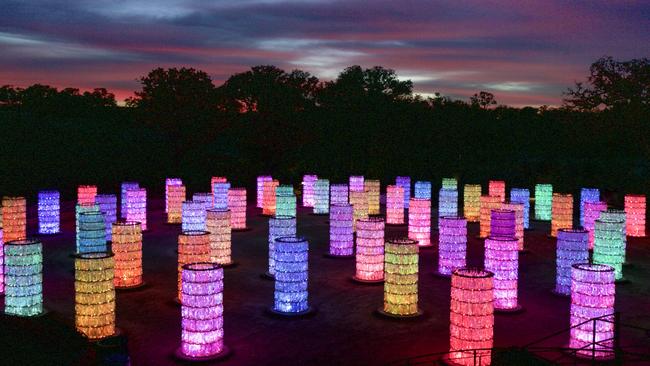
Colossal size lies at the heart of the Red Centre’s appeal; in the vastness of the landscape shaped over eons of time. Stand in the ochre dust, with only a ribbon of road heading arrow-straight through the desert plains, and it could be 1000 or 10,000 years in the past.
Kings Canyon rises almost miraculously above the horizon in Watarrka National Park, 450km west of Alice Springs. Its glorious, soaring red rock and sandstone cliffs, now enclosing a green valley, were formed over 400 million years ago. This geological reality is so mind boggling that visiting it feels transformative, even spiritually uplifting. Its dramatically rugged beauty became iconic in cinema classic The Adventures of Priscilla, Queen of the Desert (1994), when the three drag queen protagonists – surreally out of place and as far from the city as it gets – stood at its edges, in all their glittery glory.

Now another creative endeavour brings shimmering, man-made magic to this natural wonder. British artist Bruce Munro, known for his large-scale, mixed-media installations, has partnered with Discovery Parks, which runs the only accommodation at Kings Canyon, to create Light-Towers, heralding a new era for the property after a two-year, $20m program of works and upgrades.
Over the past 30 years, Munro has produced temporary artworks, or “glowscapes”, in the US, Britain, Australia and South Korea. His creations are monumental in scale, in contrast to his use of the ethereal medium of light. The observer may experience wonder at a gigantic backdrop of glittering raindrops suspended in a vaulted, holy space (Light Shower at Salisbury Cathedral in Wiltshire) or a reflective sea of molten silver over an undulating landscape (CDSea at nearby Long Knoll Field), but a closer look reveals they have been composed from repurposed everyday materials, made luminous and powerfully evocative by light alone. Objects, technology and art intersect to help the viewer connect with their surroundings in a new way.
In a built environment, an installation artist works with architectural and historic space. What happens when you have emptiness and infinity to play with?
“This was a challenge I loved,” enthuses Munro at the Light-Towers world premiere. “The Red Centre is the heart of this country; to me it’s the heart of the world. Why do you feel so incredibly alive here? You’re 1500 miles (2400km) from anything in every direction. The air is buzzing, the ground is buzzing; this whole place is speaking to you.”
Munro sees King’s Canyon as a transcendent, emotionally healing place. “Our lives have been taken over by so much noise. Australia is so lucky to have this place to come to, where you can really connect and plug back in. It’s important for people’s spirit.”

He credits his travels in the Outback 30 years ago with his birth as an artist. “Coming here gave me my first sense of geological time. I saw imprints of sea creatures in King’s Canyon from half a billion years ago and sensed that everything was connected; the past is as true to the present as the present is to the future. Only then did I come to realise that light could be used for pure expression.”
As our group threads along a newly built boardwalk with Munro, the cylindrical towers come into view, aglow and pulsing gold, pink, coral, blue and mint green. Nature is jagged and wild around us. Storm clouds race above, and the rocky outcrops of the canyon loom ahead among the desert spinifex. As we walk amid the towers, the music of British composer Orlando Gough swirls around, a chorus of human voices singing contrapuntal chords, each cascading and blending into the next in a spellbinding melodic pattern.
Up close, it becomes clear each tower’s source of colour is fibre optics, encased in that most innocent of domestic objects: the milk bottle. In the natural world’s isolation, any foreign object takes on the talismanic weight of representing outside culture.
“Look at the beauty of an ordinary bottle,” Munro says. “It’s a utilitarian object that we’re so familiar with, but if you showed that bottle to someone 500 years ago they would have put it on a pedestal. I love manufactured items and the repeated form.”
As night falls, the ground fades from view and the towers appear to float; voices drift above, movingly human in the face of the canyon. “I have always felt that I wanted to create installations that are almost abstractions of people,” explains Munro. “They are like superbeings that are standing, singing the soul of the world in a forever day. They’re bigger than we are, but on a human scale.”
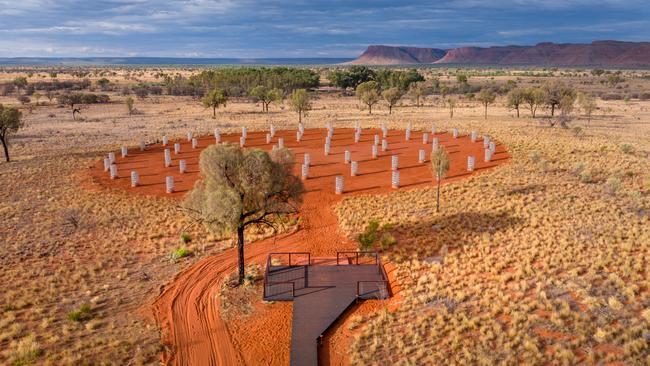
Questions of scale and perspective underpin the geological wonder of King’s Canyon, where the awe-inspiring landscape is allowed to dominate. Discovery Resorts – Kings Canyon is nestled into the land, hidden from guests’ view until arrival. The five-hour journey from Alice Springs gives the traveller a sense of the unyielding ruggedness of the land. Dingoes dart over the pink-brown sands between the silvery greys of outback grasses; ridges collapse into jagged rocks, tumbling like the discarded toys of a giant. We traverse a cattle property, Kings Canyon Station, that is 1800sq km alone.
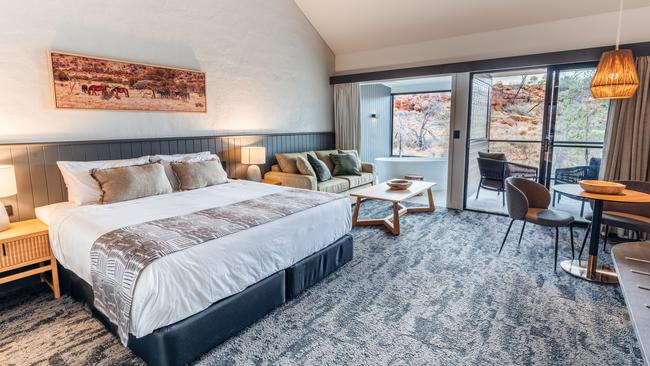
The resort is a true oasis. The new Deluxe Rooms feature the creature comforts of airconditioning, plush carpeting and crisp bedding. A freestanding bath by a picture window overlooks an escarpment of salmon-pink rocks. A small balcony allows you to revel in the dry desert air. The resort also has safari-style glamping tents with expansive views. A swimming pool and tennis court round out the recreational touches.
Carmichael’s Restaurant’s spirited locavore menu showcases Australian ingredients such as smoked kangaroo, crocodile dumplings and emu koftas, and a generous breakfast buffet has fresh fruit and seafood. Diners can keep it simple with wood-fired pizzas at the newly built Bar & Grill. The resort doesn’t waste its canopy of stars. Under A Desert Moon is a five-course outdoor experience, and dining is also available at the Luritja Lookout, overlooking the Light-Towers as they come to life.

Munro says he was awestruck by how First Nations people have lived harmoniously in this environment for 60,000 years, and agreed to create art here (including his immersive walking trail Field of Light at Uluru) because of their “kind welcome”.
He sees his unique works as storytelling. “Lighting for me is painting. In this unstable, divided era – the scariest in my lifetime – the towers are humanity reaching out. I believe in science. We are all made from the same stuff: stars. We should cherish each other with loving kindness. These landscapes and the people from them can teach us new ways to live a more fulfilled life.”
Cleo Glyde was a guest of Discovery Resorts – Kings Canyon.
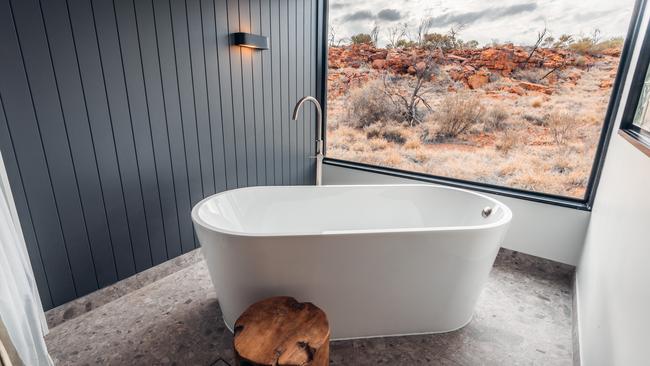
In The Know
Discovery Resorts – Kings Canyon can organise tours for travellers who want to experience the Indigenous culture of Watarrka National Park (jointly managed by the Traditional Owners and Parks and Wildlife) as well as
Light-Towers. At the neighbouring community of Karrke, Aboriginal people explain their bloodline, and the significance of bush tucker, medicine, dot painting and artefacts made by the local Luritja and Pertame (Southern Aranda) people.
Nearby, Kings Canyon Rim Walk (6km loop) rewards an initial steep climb with spectacular views past ancient cycads and a spring-fed waterhole within the canyon. The easier Kathleen Springs Walk (2.6km) runs at ground level between the canyon’s sheer walls.
Superior glamping tents from $430; deluxe rooms from $480.



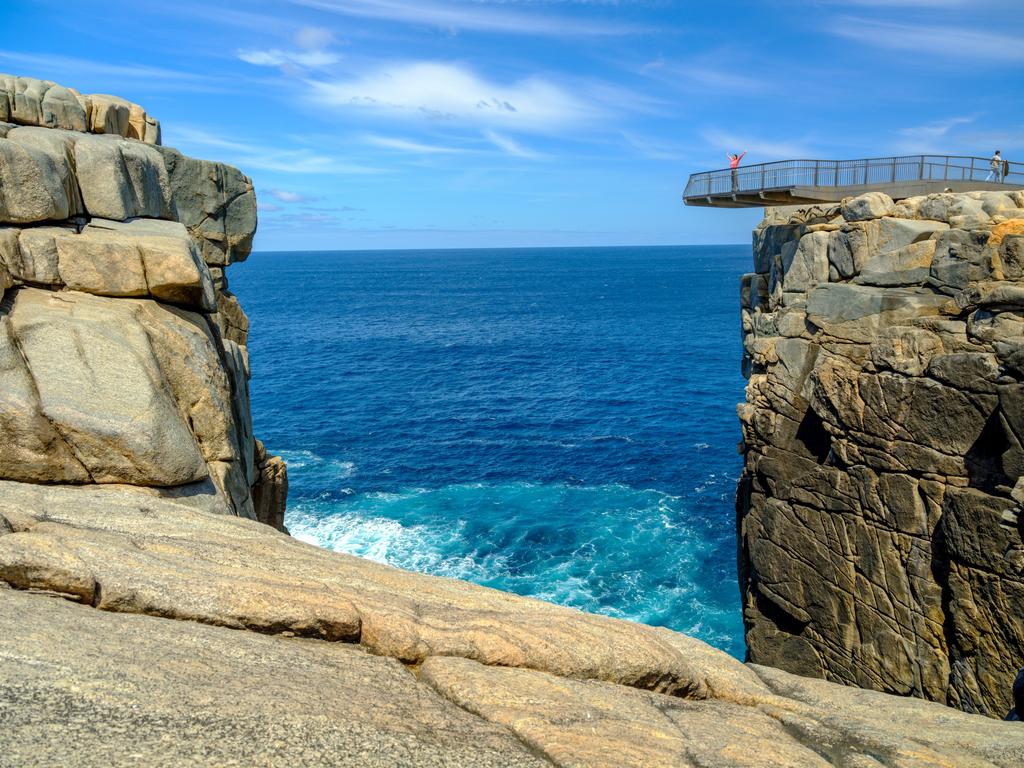

To join the conversation, please log in. Don't have an account? Register
Join the conversation, you are commenting as Logout